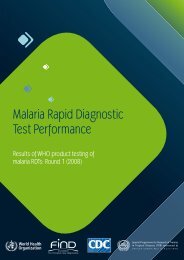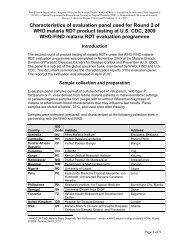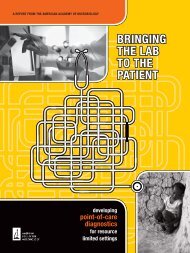Download in English [pdf 2Mb] - Foundation for Innovative New ...
Download in English [pdf 2Mb] - Foundation for Innovative New ...
Download in English [pdf 2Mb] - Foundation for Innovative New ...
- No tags were found...
You also want an ePaper? Increase the reach of your titles
YUMPU automatically turns print PDFs into web optimized ePapers that Google loves.
REGIONAL PLATFORM FOR CLINICAL RESEARCHHUMAN AFRICAN TRYPANOSOMIASIS HAT1. Editorial .......................................................... P.22. Report of the regional HATPlat<strong>for</strong>m steer<strong>in</strong>gcommittee meet<strong>in</strong>g, held <strong>in</strong> Bamako on11 September 2011 1.................................... P.33. Salient po<strong>in</strong>ts of the 31st Conference of theInternational Scientific Council <strong>for</strong> TrypanosomiasisResearch and Control (ISCTRC) ..........P.64. 7th European Congress on Tropical Medic<strong>in</strong>e& International Health <strong>in</strong> Barcelona ............... P.85. Tra<strong>in</strong><strong>in</strong>g <strong>in</strong> cl<strong>in</strong>ical research and Good Cl<strong>in</strong>icalPractice ........................................................ P.116. Update on on-go<strong>in</strong>g research ...................... P.127. Floor Given to patients and caregivers ........ P.178. 2012 scientific meet<strong>in</strong>gs and websites of<strong>in</strong>terest ........................................................ P. 199. Recent publications on HAT ...........................P. 20EditorialToday, we are publish<strong>in</strong>g our tenth newsletter of the HAT plat<strong>for</strong>m,which <strong>in</strong>cludes two releases per year. We have been present<strong>in</strong> major scientific <strong>for</strong>ums which we present <strong>in</strong> this issue thema<strong>in</strong> l<strong>in</strong>es related to the objectives of our HAT plat<strong>for</strong>m.Updates on current research <strong>in</strong> the field of diagnosis and treatment ofthe sleep<strong>in</strong>g sickness are very encourag<strong>in</strong>g, <strong>in</strong> this bullet<strong>in</strong> our partnersshow the ma<strong>in</strong> ones, supported with images. A novelty <strong>in</strong> this bullet<strong>in</strong>is to give a good place to the testimony of the ma<strong>in</strong> beneficiaries of ouraction, both patients and caregivers. Tak<strong>in</strong>g advantage of this time ofyear, the HAT plat<strong>for</strong>m coord<strong>in</strong>ation on behalf of all its members havethe pleasure and the duty to wish you many good th<strong>in</strong>gs <strong>for</strong> the com<strong>in</strong>gYear <strong>in</strong>clud<strong>in</strong>g a good read<strong>in</strong>g2 NEWSLETTER N°10 / DECEMBER 2011
REGIONAL PLATFORM FOR CLINICAL RESEARCHHUMAN AFRICAN TRYPANOSOMIASIS HATReport of the regional HAT Plat<strong>for</strong>m steer<strong>in</strong>gcommittee meet<strong>in</strong>g, held <strong>in</strong> Bamakoon 11 September 2011The steer<strong>in</strong>g committee is responsible <strong>for</strong> the supervisionof the HAT Plat<strong>for</strong>m operation, and meets at least twicea year. The first meet<strong>in</strong>g this year was held <strong>in</strong> Bangui,and the second one was held on 11 September 2011, dur<strong>in</strong>gthe 31st Conference of the International Scientific Council<strong>for</strong> Trypanosomiasis Research and Control (ISCTRC) <strong>in</strong> Bamako,Mali.All the endemic member states, with the exception of Chad,were represented, i.e. the Republic of Angola, the CentralAfrican Republic, the Democratic Republic of Congo, theRepublic of Congo, the Islamic Republic of Sudan, the Republicof South Sudan, and the Republic of Uganda. Six of ourtraditional partners were also present at this meet<strong>in</strong>g: DNDi,Suisse-TPH, FIND, CTB, EANETT and MSF.Some of the topics addressed dur<strong>in</strong>g the meet<strong>in</strong>g are describedbelow.a) Review of the HAT Plat<strong>for</strong>m activities overthe past five yearsThe outcome of the tra<strong>in</strong><strong>in</strong>g activities organised <strong>for</strong> researcherand ethics committees is positive. All scheduled tra<strong>in</strong><strong>in</strong>gsessions were carried out as planned (except <strong>for</strong> one session<strong>for</strong> the ethics committee <strong>in</strong> Congo Brazzaville not carriedout).In terms of communication, the HAT Plat<strong>for</strong>m produced n<strong>in</strong>enewsletters over this period, as well as numerous televisionand radio broadcasts, meet<strong>in</strong>gs, etc.©Photo W. MUTOMBOHATplat<strong>for</strong>m Steer<strong>in</strong>g committee members, Bamako/Malie September 2011 Workshop steer<strong>in</strong>g committee members Bamako/Malie September 2011©Photo W. MUTOMBOAnalysis : Strong po<strong>in</strong>ts / Weak po<strong>in</strong>tsSTRONG POINTSRegular f<strong>in</strong>ancial supportTra<strong>in</strong><strong>in</strong>g sessions carried outSupport of field activitiesConferences (scientific or steer<strong>in</strong>g committee)<strong>New</strong>slettersSett<strong>in</strong>g up/ re<strong>in</strong><strong>for</strong>c<strong>in</strong>g the countries’ ethics committeesAdoption and implementation of NECTCl<strong>in</strong>ical research on new drugsCollaboration with FIND on improv<strong>in</strong>g the diagnosisJo<strong>in</strong>t meet<strong>in</strong>g with EANETTWEAK POINTSLittle use of tra<strong>in</strong>ed monitors on a national or regional levelInsufficient field visitsTerm<strong>in</strong>ation of the DB289 cl<strong>in</strong>ical trialLittle or no use of regional expertsLack of <strong>in</strong>teraction with other areas of HAT research (diagnosis,tsetse flies, socio-economic studies, etc.)Little collaboration dur<strong>in</strong>g meet<strong>in</strong>gs with other key actors(OCEAC, etc…)3 NEWSLETTER N°10 / DECEMBER 2011
REGIONAL PLATFORM FOR CLINICAL RESEARCHHUMAN AFRICAN TRYPANOSOMIASIS HATA debate was launched on how to improve the fex<strong>in</strong>idazolestudy protocol. The question was whether the adjuncttreatments are to be given systematically, or only once thediagnosis is confirmed, prior to the <strong>in</strong>clusion of the patient<strong>in</strong> the study. Each patient will undergo a ‘wash-out period’between the end of this treatment and the beg<strong>in</strong>n<strong>in</strong>g of theadm<strong>in</strong>istration of fex<strong>in</strong>idazole (the duration of this wash-outperiod will depend on the half-life of the molecule used).The patient’s <strong>in</strong><strong>for</strong>med consent and the post-treatment folb)Proposed strategic plan <strong>for</strong> 2012-2014The HAT Plat<strong>for</strong>m has been com<strong>in</strong>g up to speed over its firstfive years of existence. It is now time to consolidate the supportsand br<strong>in</strong>g <strong>in</strong> <strong>in</strong>novations. Consequently, the follow<strong>in</strong>gma<strong>in</strong> l<strong>in</strong>es of actions have been suggested <strong>for</strong> 2012-2014.LINES OF ACTIONCommentsStrengthen<strong>in</strong>g the capacitiesof member statesStrengthen<strong>in</strong>g the capacitiesof local researchersInvolvement <strong>in</strong> current andfuture studies- Tra<strong>in</strong><strong>in</strong>g plan with success <strong>in</strong>dicators- Content of the module- Timetable (where, who, etc.)- Document update- Evaluation of the tra<strong>in</strong><strong>in</strong>g impact- Confirm future study sites- Monitor<strong>in</strong>g and use of local monitors- Participation to scientific congresses /conferences- Need to ensure fund<strong>in</strong>g <strong>for</strong> all mentioned activitiesTreatment:- Implementation of the fex<strong>in</strong>idazole study- Monitor<strong>in</strong>g of NECT implementation + Pharmacovigilance- Possibility to <strong>in</strong>clude with<strong>in</strong> the Plat<strong>for</strong>m low-endemic countries (e.g. Gabon,Gu<strong>in</strong>ea, Cameroon) as consultants, or <strong>for</strong> short periods as neededDiagnosis:- Tools to determ<strong>in</strong>e the disease stage and follow-up tools- List of <strong>in</strong>itiatives and def<strong>in</strong>ition of the added value of each diagnostic tool- Promote the evaluation/validation of new diagnostic toolsAdvocacy and fundrais<strong>in</strong>g - Communication/advocacy- Email / teleconference exchanges- <strong>New</strong>sletter circulation by email- Increase the use of DNDi website to promote Plat<strong>for</strong>m activities- Participation to various meet<strong>in</strong>gs- Steer<strong>in</strong>g committee- Scientific <strong>for</strong>um- Annual scientific meet<strong>in</strong>g + EANETT- Organisation of work<strong>in</strong>g groups per specific subject- Fundrais<strong>in</strong>g- Individual fundrais<strong>in</strong>g plans (when, how much, etc…) <strong>for</strong> each project- Recruitment of fundrais<strong>in</strong>g specialists to target donorsA specific work group has been created to f<strong>in</strong>alise this strategicplan. The novelty is the <strong>in</strong>clusion of cross-sectoral thematicissues (e.g. role of the Plat<strong>for</strong>m <strong>in</strong> the compilation of cl<strong>in</strong>icalresearch documents, and coord<strong>in</strong>ation with the countries’regulatory authorities dur<strong>in</strong>g research projects).c) Contribution of the HAT Plat<strong>for</strong>m to ongo<strong>in</strong>gstudies.The steer<strong>in</strong>g committee discussed the validation and approvalprocess by the countries’ ethics committees. The example offex<strong>in</strong>idazole will help strengthen the capacities and encourageexchanges between ethics committees.4 NEWSLETTER N°10 / DECEMBER 2011
REGIONAL PLATFORM FOR CLINICAL RESEARCHHUMAN AFRICAN TRYPANOSOMIASIS HATWorkshop steer<strong>in</strong>g committee members Bamako/Malie September 2011low-up protocol were exam<strong>in</strong>ed and proposals were made<strong>for</strong> their improvement.d) The <strong>in</strong>volvement of HAT Plat<strong>for</strong>m partnersDur<strong>in</strong>g this meet<strong>in</strong>g, the various partners provided <strong>in</strong><strong>for</strong>mationon their on-go<strong>in</strong>g projects:• Swiss-TPH: presentation of the different areas ofresearch and explanations on the term<strong>in</strong>ation of the DB289 study;• MSF: presentation of the HAT mobile team (MSF-Holland), its objectives, activities, etc.;• FIND: presentation of its on-go<strong>in</strong>g studies, <strong>in</strong>clud<strong>in</strong>g RDT SD-Biol<strong>in</strong>e, I-led, MolecularLAMP, Biomarkers CSF;• EANETT: presentation of its plat<strong>for</strong>m and ma<strong>in</strong>activities;• Research group on tsetse flies, human and animaltrypanosomiasis;Workshop steer<strong>in</strong>g committee members Bamako/Malie September 2011©Photo W. MUTOMBO©Photo W. MUTOMBOWorkshop steer<strong>in</strong>g committee members Bamako/Malie September 2011• Pharmacok<strong>in</strong>etics;• Evaluation of diagnostic tools <strong>for</strong> the detection ofthe parasite <strong>in</strong> animalse) Preparation of the 2012 annual scientificmeet<strong>in</strong>g, held jo<strong>in</strong>tly by EANETT and the HATPlat<strong>for</strong>mThe Committee confirmed its decision to organise this scientific<strong>for</strong>um <strong>in</strong> Juba, Republic of South Sudan, <strong>in</strong> September2012.A scientific and logistics committee was created to organisethis major meet<strong>in</strong>g. A special ef<strong>for</strong>t must be made to attractyoung African researchers, possibly with fund<strong>in</strong>g to helpthem attend and present their work.Laurence Flévaud (reporter),August<strong>in</strong> Kadima Ebeja (coord<strong>in</strong>ator)Workshop steer<strong>in</strong>g committee members Bamako/Malie September 2011©Photo W. MUTOMBO ©Photo W. MUTOMBO5 NEWSLETTER N°10 / DECEMBER 2011
REGIONAL PLATFORM FOR CLINICAL RESEARCHHUMAN AFRICAN TRYPANOSOMIASIS HATSalient po<strong>in</strong>ts of the 31st Conference of the InternationalScientific Council <strong>for</strong> Trypanosomiasis Research andControl (ISCTRC)©Photo W. MUTOMBOHATplat<strong>for</strong>m delegates to the ISCTRC meet<strong>in</strong>g Bamako/Malie September 2011 HATplat<strong>for</strong>m delegates to the ISCTRC meet<strong>in</strong>g Bamako/Malie September 2011©Photo W. MUTOMBOThe conference was held <strong>in</strong> Bamako on 12-16 September2011, <strong>in</strong> the large room of the Bamako InternationalConference Centre (CICB), under the high patronageof the Her Excellency Mrs. Cissé Mariam Kaïdama Sidibé,Prime M<strong>in</strong>ister, Head of Government, with the collaborationof the African Union, and coord<strong>in</strong>ated by the Inter-AfricanBureau <strong>for</strong> Animal Resources.Over 340 participants attended this scientific meet<strong>in</strong>g, represent<strong>in</strong>g36 African countries and 10 Western countries. Allthe HAT Plat<strong>for</strong>m member countries were present and overthirty of their representatives were funded by DNDiThe meet<strong>in</strong>g was organised <strong>in</strong> several sessions:• Reports from <strong>in</strong>ternational organisations• Reports from the countries affected by the disease(national) and PATTEC• Presentation of articles on HAT and animal AfricanTrypanosomiasis (AAT)• Discussion on the posters• F<strong>in</strong>al recommendations1. REPORTS FROM INTERNATIONALORGANISATIONSDur<strong>in</strong>g the meet<strong>in</strong>g, chaired by Dr. Baba Soumare with Dr.José Ramon Franco act<strong>in</strong>g as reporter, several <strong>in</strong>ternationalorganisations presented their reports. These organisations<strong>in</strong>cluded the World Health Organisation (WHO), the Foodand Agriculture Organisation (FAO), the Programme Aga<strong>in</strong>stAfrican Trypanosomiasis (PAAT), the Agence Internationalede l'Énergie Atomique (IAEA), the Global Alliance <strong>for</strong> LivestockVeter<strong>in</strong>ary Medic<strong>in</strong>es (GALVmed), the Eastern AfricaNetwork <strong>for</strong> Trypanosomiasis (EANETT), the Centre Internationalde Physiologie et d’Écologie des Insectes (ICIPE),the Centre International de Recherche-Développement enZone Subhumide (CIRDES), the International Livestock ResearchInstitute (IRLI), Drug <strong>for</strong> Neglected Diseases <strong>in</strong>itiative(DNDi), etc.Overall, progress has been achieved over the past few years<strong>in</strong> HAT research and control. The money <strong>in</strong>vested by <strong>in</strong>ternationalorganisations helped reduce the number of HATcases <strong>in</strong> previously endemic areas.2. REPORTS FROM THE COUNTRIESAFFECTED BY HAT AND AATThe heads of national HAT and AAT control programmespresented the activity reports <strong>for</strong> their respective countries.They all reported a cont<strong>in</strong>u<strong>in</strong>g control and reduction <strong>in</strong> thenumber of cases follow<strong>in</strong>g the collaboration with <strong>in</strong>ternationaland regional organisations.3. PRESENTATIONS OF ARTICLES ON HATAND AATAll 78 presentations focused on a s<strong>in</strong>gle theme, i.e. approach<strong>in</strong>gresearch and control of tsetse flies and trypanosomiasisas a development program:• Human African trypanosomiasis: epidemiology, diagnosis,and chemotherapy6 NEWSLETTER N°10 / DECEMBER 2011
REGIONAL PLATFORM FOR CLINICAL RESEARCHHUMAN AFRICAN TRYPANOSOMIASIS HATHATplat<strong>for</strong>m delegates to the ISCTRC meet<strong>in</strong>g Bamako/Malie September 2011 Others ISCTRC meet<strong>in</strong>g participants Bamako/Malie September 2011©Photo W. MUTOMBO©Photo W. MUTOMBO• Animal African trypanosomiasis: chemotherapy,chemoresistance, and epidemiology• Gloss<strong>in</strong>a biology, control, and eradication• Use of land, environment, and socio-economy4. POSTER DISCUSSIONThe Chairperson <strong>for</strong> this session, Dr. Ahmed H.A rem<strong>in</strong>dedthe participants that posters are not a second-class method,but <strong>in</strong>stead are true scientific documents designed to helpyoung scientists publish their work and get exposure to the<strong>in</strong>ternational scientific community.The poster of our HAT Plat<strong>for</strong>m was one of the 37 postersaccepted by the Council out of 58 applicants.5. COUNCIL RECOMMENDATIONSVarious recommendations were made <strong>for</strong> each of the representedstructures and organisations, of which some are listedbelow:1. For the WHO:• Cont<strong>in</strong>ue to help the activities of HAT control,transmission and identification of isolated regions <strong>in</strong> endemiccountries, to break the cha<strong>in</strong> of transmission of the disease;• Develop an <strong>in</strong>novat<strong>in</strong>g system based on monitor<strong>in</strong>gand tak<strong>in</strong>g <strong>in</strong>to account different epidemiological situations;• Complete the HAT Atlas and supply the countrieswith materials.2. For the FAO:• Ma<strong>in</strong>ta<strong>in</strong> technical assistance <strong>in</strong> endemic countries;• Cont<strong>in</strong>ue the cooperation with partners <strong>in</strong> the field,especially PATTEC;• Re<strong>in</strong><strong>for</strong>ce management and data analysis capacities;• Contribute to the control and quality assurance ofprojects be<strong>in</strong>g set up, focus<strong>in</strong>g on monitor<strong>in</strong>g and evaluation.3. For PAAT:• Circulate the strategy plan;• Rebuild PAAT structures;• Re<strong>in</strong><strong>for</strong>ce collaboration and exchanges betweenPAAT and PATTEC;• Re<strong>in</strong><strong>for</strong>ce the capacities of various tra<strong>in</strong><strong>in</strong>g programmes;• Cont<strong>in</strong>ue to publish scientific and technical newsletters.4. For national HAT programs, DNDi, and otherpartners:• Resources must cont<strong>in</strong>ue to be allocated to HATcontrol, even <strong>in</strong> countries that have reached the elim<strong>in</strong>ationstage, and thereby avoid enormous expenditures <strong>in</strong> theevent of a resurgence.• The risk estimation model should also <strong>in</strong>clude HATdue to T.b. rhodesiense.• F<strong>in</strong>d ways to reduce the post-treatment follow-upperiod by us<strong>in</strong>g new biomarkers, such as neopter<strong>in</strong>e. Othersources of antigens should be exam<strong>in</strong>ed to provide otheroptions <strong>for</strong> HAT screen<strong>in</strong>g tests, such as TDR.• Further tests are required <strong>for</strong> fex<strong>in</strong>idazole andSCYX-7158 (oxaborole) <strong>in</strong> phase I and II trials, to determ<strong>in</strong>etheir usefulness as new and safe trypanocides, potentiallyable to elim<strong>in</strong>ate the need <strong>for</strong> lumbar taps, a procedurewhich limits the efficacy of control ef<strong>for</strong>ts.Dr. Digas NGOLO,Dr. Pathou NGANZOBO,and Dr. Kadima Ebeja August<strong>in</strong>7 NEWSLETTER N°10 / DECEMBER 2011
REGIONAL PLATFORM FOR CLINICAL RESEARCHHUMAN AFRICAN TRYPANOSOMIASIS HAT7th European Congress on Tropical Medic<strong>in</strong>e& International Health <strong>in</strong> Barcelona©Photo W. MUTOMBOHATplat<strong>for</strong>m poster exhibition, Barcelona October 2011The 7th European Congress on Tropical Medic<strong>in</strong>e &International Health was held <strong>in</strong> Barcelona, Spa<strong>in</strong>, on3-6 October 2011.“Sawubona Barcelona”, the official greet<strong>in</strong>g of our congress,means "We see you" <strong>in</strong> Zulu: we chose it not only becauseit is a beautiful way of welcom<strong>in</strong>g each other, but <strong>for</strong> itsstrength as a shared ethical commitment. .This scientific meet<strong>in</strong>g was attended by 1350 participantsand 335 speakers. Oral communications were divided <strong>in</strong>tofour ma<strong>in</strong> groups:• Infectious diseases and neglected diseases• Mother and child health• Chronic diseases and environmental health• Healthcare systems and resourcesDur<strong>in</strong>g the HAT session held on 5 October 2011, the WHOdescribed the current situation of the disease (disease burden)and its geographical distribution. The University of Verona(Italy) presented the neurological aspects of sleep<strong>in</strong>gsickness, and DNDi presented the multicentre NECT-Fieldstudy, <strong>in</strong> which our HAT Plat<strong>for</strong>m play a prom<strong>in</strong>ent role.Oral presentation of the HATplat<strong>for</strong>m by Dr A.EbejaA study compar<strong>in</strong>g the long and short pentamid<strong>in</strong>e regimens(10 days versus 7 days) was also presented. Its conclusionwas that the efficacy of the 10-day regimen was superior tothat of the 7-day regimen.Our Plat<strong>for</strong>m presented two posters and gave one oral presentation.One of the posters was on the health researchpolicy <strong>in</strong> South Sudan, and the other on the three plat<strong>for</strong>ms<strong>in</strong>itiated by DNDi (LEAP, CHAGAS and HAT), and dedicatedto f<strong>in</strong>d<strong>in</strong>g solutions to these neglected diseases basedon their specific parameters.The oral presentation provided us with another opportunityto review the history of the HAT Plat<strong>for</strong>m, its objectives,its ma<strong>in</strong> achievements, and the lessons learned. Wehanded out a large number of the Plat<strong>for</strong>m <strong>New</strong>slettersn°8 and 9.Among the many cross-sectional sessions, the one entitled« Science of Elim<strong>in</strong>ation » was particularly <strong>in</strong>terest<strong>in</strong>g.A panel of scientists, chaired by Prof. Marcel Tanner (Directorof Swiss Tropical and the Public Health Institute),participated <strong>in</strong> the discussion: Dr. Bernard Pécoul (DNDiexecutive director), Prof. Pedro Alonso (Director of theBarcelona Institute <strong>for</strong> Global Health ISGlobal and of theBarcelona Centre <strong>for</strong> International Health Research CRE-SIB), Prof. Rose Leke (President of the African RegionalCertification Commission), and Dr. Jean Jann<strong>in</strong> (WHO /NTD).Prof. Tanner stressed the importance of an accurate def<strong>in</strong>itionof elim<strong>in</strong>ation and eradication, as policy makersmay decide to opt <strong>for</strong> one or the other. However, this is aquestion <strong>for</strong> scientists because the decision must be basedon the type of condition and other feasibility aspects. Hegave the follow<strong>in</strong>g def<strong>in</strong>itions:• Control: reduction of the disease burden• Elim<strong>in</strong>ation: elim<strong>in</strong>ation of local transmission (<strong>in</strong> agiven region, country)• Eradication: complete elim<strong>in</strong>ation of the parasiteworldwideDr. Jean Jann<strong>in</strong> expla<strong>in</strong>ed that, based on his own personalexperience as the WHO does not have a clear-cut posi-©Photo W. MUTOMBO8 NEWSLETTER N°10 / DECEMBER 2011
REGIONAL PLATFORM FOR CLINICAL RESEARCHHUMAN AFRICAN TRYPANOSOMIASIS HATScientific Panel chaired by Professor Marcel Tannertion on these dist<strong>in</strong>ctions, the most important factors whentalk<strong>in</strong>g of elim<strong>in</strong>ation are the criteria and <strong>in</strong>dicators show<strong>in</strong>ga reduction <strong>in</strong> the burden of the disease.Eradication occurs when there is concrete evidence of theabsence of the disease.Several diseases have been elim<strong>in</strong>ated <strong>in</strong> the past (e.g.HAT), but eventually resurgences occur. This shows thatthe concept of elim<strong>in</strong>ation is closely l<strong>in</strong>ked to how long itlasts. The lack of means to ma<strong>in</strong>ta<strong>in</strong> an effective control onthe disease is the cause of such failures. The challenge isthus to ensure that elim<strong>in</strong>ation lasts.The WHO lists some eradication programs, such as:• Poliomyelitis• Gu<strong>in</strong>ea worm disease (eradicated expected by2015)• Lymphatic filariasis (eradicated expected by 2020)• HAT, onchocerciasis, rabies, etc.©Photo W. MUTOMBOProf. Rose, as an immunologist, described the polio eradicationprogram <strong>in</strong> India, where the annual number of caseshas dropped by 99%. The problem seems to be the availabilityof means and mobilisation of populations.Elim<strong>in</strong>ation must come from the countries or the regions,because, as seen with malaria, elim<strong>in</strong>ation may be pronouncedon a global level, when <strong>in</strong> fact certa<strong>in</strong> areas ofAfrica are still try<strong>in</strong>g to ma<strong>in</strong>ta<strong>in</strong> a last<strong>in</strong>g control.Dr. Bernard Pécoul considers that as long as politicians donot admit the extent of the problem, elim<strong>in</strong>ation or eradicationwill rema<strong>in</strong> empty words. However, as a scientist, hedoes also admit that current tools are not effective enoughto ensure the elim<strong>in</strong>ation of neglected diseases, such as humanAfrican trypanosomiasis, leishmaniasis, and lymphaticfilariasis.Diagnostic and treatment tools <strong>for</strong> these diseases are complicatedand require a functional cold cha<strong>in</strong>. Although theexample of NECT showed that the care of patients can beimproved with a less toxic product, the determ<strong>in</strong>ation ofthe stage of the disease (lumbar tap), and the adm<strong>in</strong>istrationof DFMO <strong>in</strong>fusions rema<strong>in</strong> a problem. Consequently,patients cannot be treated <strong>in</strong> their villages.Research is there<strong>for</strong>e needed to f<strong>in</strong>d simple diagnostic toolsand a treatment effective on both stages of sleep<strong>in</strong>gsickness. An appropriate strategy <strong>for</strong> leishmaniasis is alsoneeded.The treatment of patients with lymphatic filariasis with microfilaricidescan <strong>in</strong>duce serious side effects <strong>in</strong> patients co<strong>in</strong>fectedwith Loa loa. A more appropriate strategy wouldbe to f<strong>in</strong>d a macrofilaricide (which kills only adult filariae)to treat lymphatic filariasis.As the development of diagnostic and treatment toolstakes 5 to 10 years, the elim<strong>in</strong>ation of these diseases is stillnot with<strong>in</strong> reach.In his clos<strong>in</strong>g address, Prof. Manuel Corachán expla<strong>in</strong>edthat tropical medic<strong>in</strong>e and global health research play acentral role <strong>in</strong> the Millennium Development Goals (MDGs).However, the objectives are far from be<strong>in</strong>g met and thoserelated to health are the least likely to be achieved. It is <strong>for</strong>researchers to produce evidence-based data <strong>for</strong> policy makers.They must also monitor and evaluate progress, basedon quantitative and qualitative results, and suggest solutionsto improve the efficiency of policies.Prof. Corachán made a series of recommendations <strong>for</strong> <strong>in</strong>fectiousand neglected diseases, some of which are detailedbelow.a. Malaria:• Still responsible <strong>for</strong> approximately 800,000 deathsevery year, which is unacceptable.• The pathophysiology of severe malaria has yet tobe clarified.• Rapid diagnostic tests (RDTs) provided abreakthrough <strong>in</strong> diagnosis.• A fever is no longer systematically caused bymalaria.• <strong>New</strong> drugs are <strong>in</strong> the pipel<strong>in</strong>e, but it will take timebe<strong>for</strong>e they can be used.• The availability of vacc<strong>in</strong>es is closer than ever.• Pyrethroid resistance is spread<strong>in</strong>g.• Eradication is a global goal, but unrealistic expectations must be avoided.DNDi and MSF stand at the 7th European Congress on Tropical Medic<strong>in</strong>e& International Health <strong>in</strong> Barcelona©Photo W. MUTOMBO9 NEWSLETTER N°10 / DECEMBER 2011
REGIONAL PLATFORM FOR CLINICAL RESEARCHHUMAN AFRICAN TRYPANOSOMIASIS HATProf. Marleen Boelaert of IMT. Anvers©Photo W. MUTOMBODr. François Chappuis of Geneva University©Photo W. MUTOMBOb. Leishmaniasis• More research is needed <strong>in</strong> vector control methods.• Affected communities still have limited access todrugs.c. Vector-borne diseases• The global spread of mosquito vectors raises thethreat of outbreaks of chikungunya, dengue fever,and West Nile fever <strong>in</strong> Europe.• Increas<strong>in</strong>g people movements due to migration,trade and travels are an added risk factor.• <strong>New</strong> vacc<strong>in</strong>es and new control strategies are necessary.d. Chagas disease (American trypanosomiasis)• Cl<strong>in</strong>ical trials are needed to evaluate new drugs<strong>for</strong> the chronic stages, <strong>in</strong>clud<strong>in</strong>g promis<strong>in</strong>gazole derivatives.• A new presentation of benznidazole <strong>for</strong> childrenwill be available shortly.• A solution to drug stock-outs must be foundurgently.e. HIV <strong>in</strong>fection• The recent success of pre-exposure prophylaxisto prevent HIV <strong>in</strong>fection has lead to the discoveryof new tools: microbicide gels, vag<strong>in</strong>al r<strong>in</strong>gs andoral tablets.• Research on HIV vacc<strong>in</strong>e is benefitt<strong>in</strong>g from datagenerated by previous trials and by fundamentalresearch.• Re<strong>in</strong><strong>for</strong>cement of capacities rema<strong>in</strong>s a priority <strong>in</strong>low-resource countries, where HIV prevalence ishigh, and where trials are be<strong>in</strong>g conducted.• <strong>Innovative</strong> approaches <strong>in</strong> HIV test<strong>in</strong>g, <strong>in</strong>clud<strong>in</strong>g aself-adm<strong>in</strong>istered test, have been developed <strong>for</strong>migrant populations.• The future challenges related to HIV management<strong>in</strong> heterogeneous migrant groups <strong>in</strong> Europe areunder discussion.f. Tuberculosis• <strong>New</strong> tools <strong>for</strong> TB diagnosis, treatment, and vacc<strong>in</strong>es are needed.• The relevance of screen<strong>in</strong>g <strong>for</strong> active and latentTB <strong>in</strong> migrants is under discussion.Prof. Manuel Corachán ended his clos<strong>in</strong>g address by reiterat<strong>in</strong>gthe need to endorse the Verona Declaration, whichemphasizes the right to health as a fundamental humanright <strong>for</strong> all the people, irrespective of orig<strong>in</strong>, ethnicity, andlegal status.Further details on the other recommendations can beviewed on www.ectmihbarcelona2011.org/doc/Dr. Kadima Ebeja August<strong>in</strong>,HAT Plat<strong>for</strong>m Coord<strong>in</strong>ator10 NEWSLETTER N°10 / DECEMBER 2011
REGIONAL PLATFORM FOR CLINICAL RESEARCHHUMAN AFRICAN TRYPANOSOMIASIS HATTra<strong>in</strong><strong>in</strong>g <strong>in</strong> cl<strong>in</strong>ical research and GoodCl<strong>in</strong>ical PracticeThe sessions started with theory, followed by role-play<strong>in</strong>gsessions and practical exercises to help the participants assimilatethe data and ma<strong>in</strong>ta<strong>in</strong> focus. This method was appreciatedby all and promoted <strong>in</strong>teraction with the facilitatorsas well as with other participants experienced <strong>in</strong> cl<strong>in</strong>icalstudies.Exchanges on <strong>in</strong><strong>for</strong>med consent, and on the role of <strong>in</strong>vestigatorsand sponsors were particularly <strong>in</strong>tense.©Photo W. MUTOMBOTra<strong>in</strong><strong>in</strong>g <strong>in</strong> cl<strong>in</strong>ical research and Good Cl<strong>in</strong>ical Practice participants;centre Nganda K<strong>in</strong>shasa DRC, November 2011As part of the program to re<strong>in</strong><strong>for</strong>ce cl<strong>in</strong>ical researchcapacities, the HAT Plat<strong>for</strong>m organised a tra<strong>in</strong><strong>in</strong>gsession jo<strong>in</strong>tly with DNDi and Swiss TPH, on 25-28November 2011 <strong>in</strong> K<strong>in</strong>shasa, DRC, on the basics of cl<strong>in</strong>icalresearch and good cl<strong>in</strong>ical practice.This tra<strong>in</strong><strong>in</strong>g session was part of the preparation of the fex<strong>in</strong>idazolestudy sites.A total of 22 delegates (physicians, nurses, and laboratorytechnicians) from the Central African Republic (CAR) andthe Democratic Republic of Congo (DRC) participated <strong>in</strong>the session, officially opened by Dr. Kande (physician, directorof DRC’s national HAT control program, PNLTHA).This tra<strong>in</strong><strong>in</strong>g session was made special by the presence ofthe ma<strong>in</strong> actors of the fex<strong>in</strong>idazole project. It was led by thepeople who will be <strong>in</strong> charge of monitor<strong>in</strong>g the fex<strong>in</strong>idazolesites, as well as the medical manager of the DNDi HAT project(sponsor of the fex<strong>in</strong>idazole project).The future <strong>in</strong>vestigators and site personnel were also present.This contact and the exchanges that took place willplay an important role <strong>in</strong> the success of the implementationof the fex<strong>in</strong>idazole project.This tra<strong>in</strong><strong>in</strong>g session was a success and the assignment ofSwiss TPH has been accomplished.The network of people with cl<strong>in</strong>ical expertise with<strong>in</strong> theHAT Plat<strong>for</strong>m is gett<strong>in</strong>g stronger and broader.A prelim<strong>in</strong>ary test was conducted to evaluate the knowledgeof the participants on cl<strong>in</strong>ical research and good cl<strong>in</strong>icalpractice, after which the follow<strong>in</strong>g modules were adm<strong>in</strong>isteredby the Swiss TPH facilitators:1. Ethics <strong>in</strong> research2. Good cl<strong>in</strong>ical practice3. In<strong>for</strong>med consent4. Drug development5. Cl<strong>in</strong>ical study design6. Cl<strong>in</strong>ical study management7. Cl<strong>in</strong>ical study implementation8. Quality management and SOP9. Study documents10. Monitor<strong>in</strong>g11. Audit12. Cl<strong>in</strong>ical data record<strong>in</strong>g and management13. Adverse event report<strong>in</strong>gWork<strong>in</strong>g group dur<strong>in</strong>g the tra<strong>in</strong><strong>in</strong>gThe ball is now <strong>in</strong> our court, and it is up to us to meet thechallenge. We will start by conduct<strong>in</strong>g one of the rare phaseII studies <strong>in</strong> DRC and CAR, then ma<strong>in</strong>ta<strong>in</strong> our commitmentthrough the rest of the process, so that late-stage patientswith trypanosomiasis can be treated as easily as early-stagepatients (oral treatment).Dr. Wilfried Mutombo,participant.©Photo W. MUTOMBO11 NEWSLETTER N°10 / DECEMBER 2011
REGIONAL PLATFORM FOR CLINICAL RESEARCHHUMAN AFRICAN TRYPANOSOMIASIS HATUpdate on on-go<strong>in</strong>g researchSleep<strong>in</strong>g Sickness diagnosis: use of buffy coatsimproves the sensitivity of the m<strong>in</strong>i anionexchange centrifugation test.In Bamako, we listened to a presentation on a very usefuldiagnostic method which can detect smaller quantities oftrypanosomes than the most sensitive method currentlyavailable. Below is the official summary of this presentation.Camara Oumou1, Camara Mamadou1, Ilboudo Hamidou2,Sakande Hassan2,Kaboré Jacques2, Jamonneau V<strong>in</strong>cent2,3 et Bucheton Bruno2,31 Programme National de Lutte contre la TrypanosomoseHuma<strong>in</strong>e Africa<strong>in</strong>e, BP 851, Conakry, Gu<strong>in</strong>ée ; 2 CentreInternational de Recherche-Développement sur l’Elevageen zone Subhumide (CIRDES), 01 BP 454 Bobo-Dioulasso,Burk<strong>in</strong>a Faso ; 3 Institut de Recherche pour le Développement,Unité Mixte de Recherche IRD-CIRAD 177, Laboratoirede Recherche et de Coord<strong>in</strong>ation sur les Trypanosomoses.IRD-CIRAD, TA A-17/G, Campus International deBaillarguet, F-34398 Montpellier, France* Adresser toute correspondance à : Bruno Bucheton, Tél :+226 20 97 62 15 e-mail: bruno.bucheton@ird.frThe new protocol was first tested experimentally on serialdilution of trypanosomes and was then further evaluated<strong>in</strong> the field condition on 57 HAT patients diagnosed dur<strong>in</strong>ga medical survey carried out <strong>in</strong> Gu<strong>in</strong>ea. Experimentally,the use of buffy coats improved mAECT sensitivity by atleast five fold, and enabled to consistently detect parasites<strong>in</strong> blood at a concentration of 10 trypanosomes/ml.Dur<strong>in</strong>g the field evaluation, more patients were found positivewith mAECT-bc (96.5%) than with mAECT-blood(78.9%, Chi2=6.93, p=0.008) and lymph juice exam<strong>in</strong>ation(77.2%, Chi2=7.67, p=0.005). Furthermore thenumber of parasites per collectors was significantly higher(7.2 vs 2.6, p=0.001) when buffy coats were used <strong>in</strong>steadof blood. The use of the mAECT-bc protocol thus enablesa significant improvement of HAT parasitological diagnosis<strong>in</strong> Gu<strong>in</strong>ea, without any additional costs and would deserveto be tested <strong>in</strong> other T.b. gambiense endemic areas.Fig 1: A new simple protocol to <strong>in</strong>crease mAECT sensitivityFig 1: <strong>New</strong> collector tube to <strong>in</strong>crease the sensibility ofmAECTCollect 5 ml ofvenous blood350 µl of BCFig2: Experimental evaluation of the sensitivity threshold5 m<strong>in</strong>3 000 rpm5 m<strong>in</strong>3 000 rpmTrypanosome count<strong>in</strong> collectors76543210mAECT-bcmAECT-blood50 10 5 1 Number of trypanosome/ml of blood5/510/107/100/5 mAECT-BC (number positive/total)5/55/103/100/5 mAECT-Blood (number positive/total)50 tryp/ml 10 tryp/ml 5 tryp/ml 1 tryp/mlmAECT-bc:mAECT-blood:Threshold10 tryp/ml50 tryp/mlThe objective of this study was to evaluate a modificationof the m<strong>in</strong>i anion exchange centrifugation test (mAECT)<strong>for</strong> the diagnosis of Trypanosoma brucei gambiense humanAfrican trypanosomiasis (HAT), <strong>in</strong> which 350 μl of buffycoat withdrawn from five ml of blood are used <strong>in</strong>stead ofblood, <strong>in</strong> order to <strong>in</strong>crease the sensitivity of the test.Key words: Human African trypanosomiasis, diagnosis,buffy coat, mAECTDevelopment of a screen<strong>in</strong>g test <strong>for</strong> sleep<strong>in</strong>gsickness enters a new phaseThe Bill & Mel<strong>in</strong>da Gates <strong>Foundation</strong> (BMGF) recently renewedits fund<strong>in</strong>g to FIND <strong>for</strong> the development of a rapiddiagnostic test (RDT) <strong>for</strong> human African trypanosomiasis(HAT). The new grant will enable FIND and partners tocomplete the development, evaluation and <strong>in</strong>troduction ofa simple, low-cost lateral flow test that health workers withoutmuch tra<strong>in</strong><strong>in</strong>g will be able to use <strong>in</strong> the most remotesett<strong>in</strong>gs.Evaluation of the per<strong>for</strong>mance of the prototype RDT hasnow been <strong>in</strong>itiated <strong>in</strong> Angola, DRC and the Central AfricanRepublic. The target is to have the test <strong>in</strong>troduce <strong>for</strong> diagnosisof HAT by 2013.12 NEWSLETTER N°10 / DECEMBER 2011
REGIONAL PLATFORM FOR CLINICAL RESEARCHHUMAN AFRICAN TRYPANOSOMIASIS HAT©Photo FIND©Photo FINDThe new prototype screen<strong>in</strong>g test <strong>for</strong> HAT and accessoriesbe<strong>in</strong>g developed by FIND and SD. Procedure: 20µl fresh bloodfrom a f<strong>in</strong>ger prick is placed <strong>in</strong>to the test well, followed by 4drops of diluent. Results are read after 15 m<strong>in</strong>s. A positivesample has 2 or 3 red bands, and a negative test only one redband.Dr. Crisp<strong>in</strong> Lumbala, the pr<strong>in</strong>cipal <strong>in</strong>vestigator (right) and Dr.August<strong>in</strong> Ebeja, the study monitor, observe a technician (DieudonnéTshibangu) <strong>in</strong> the National Sleep<strong>in</strong>g Sickness Programmeof the DRC per<strong>for</strong>m<strong>in</strong>g the test on a participant’s blood dur<strong>in</strong>gon-go<strong>in</strong>g per<strong>for</strong>mance evaluation studies.The RDT will make it possible to dramatically <strong>in</strong>creasethe population screened, by mobile teams and at remotehealth posts <strong>in</strong> endemic areas.Accelerated screen<strong>in</strong>g and control of the disease will becritical to support global elim<strong>in</strong>ation ef<strong>for</strong>ts. This complementsother HAT projects at FIND, <strong>in</strong>clud<strong>in</strong>g the developmentof simple tests to confirm diagnosis, to determ<strong>in</strong>e thestage of the disease, and to confirm cure after a patient hasbeen treated.Read<strong>in</strong>g results of the prototype test aga<strong>in</strong>st a colour scale <strong>in</strong>the DRC.FIND and partners make major breakthrough<strong>in</strong> molecular diagnosis of HAT©Photo FINDEnrolment of study participants <strong>in</strong> a village <strong>in</strong> the DRC©Photo FINDThe <strong>Foundation</strong> <strong>for</strong> <strong>Innovative</strong> <strong>New</strong> Diagnostics (FIND) <strong>in</strong>Geneva and Eiken Chemical Co. Ltd have made impressiveprogress towards the development of a simple molecularmethod <strong>for</strong> diagnosis of HAT.The test, which is called LAMP, detects t<strong>in</strong>y fragments of parasiteDNA <strong>in</strong> the blood of <strong>in</strong>fected people. In September 2011,FIND and Eiken announced at the ISCTRC Conference <strong>in</strong>Bamako, Mali, that development of the test and it evaluation<strong>in</strong> experimental sett<strong>in</strong>gs had been completed. Dur<strong>in</strong>g thesame occasion, Prof. Enock Matovu of Makerere University<strong>in</strong> Uganda gave a comprehensive account of the studies theyhave been carry<strong>in</strong>g out, that confirm the potential of this test.Cl<strong>in</strong>ical evaluation of the test is go<strong>in</strong>g on <strong>in</strong> both Uganda andthe Democratic Republic of the Congo (DRC).13 NEWSLETTER N°10 / DECEMBER 2011
REGIONAL PLATFORM FOR CLINICAL RESEARCHHUMAN AFRICAN TRYPANOSOMIASIS HATThe NIDIAG study <strong>in</strong> the Democratic Republicof Congo(<strong>for</strong> the HAT Plat<strong>for</strong>m <strong>New</strong>sletter n°10 )Introduction: project overviewGlobally an estimated 1.2 billion people are affected by oneor more neglected <strong>in</strong>fectious diseases (NID). This group ofdiseases thrives among impoverished populations of develop<strong>in</strong>gcountries, <strong>in</strong> remote rural areas, urban slums andconflict zones (WHO & Carter Center 2008).Tra<strong>in</strong>ees us<strong>in</strong>g an LED light source to read HAT LAMP results©Photo FINDThey <strong>in</strong>clude a range of chronic disabl<strong>in</strong>g <strong>in</strong>fections, suchas Buruli ulcer, Chagas disease, cysticercosis, dracunculiasis,endemic treponematoses, human African trypanosomiasis(HAT), leishmaniasis, leprosy, lymphatic filariasis, onchocerciasis,schistosomiasis, soil-transmitted helm<strong>in</strong>thiasis,trachoma, food-borne trematodiasis but also more acute<strong>in</strong>fections such as brucellosis, enteric fever, melioidosis,cholera, dengue and rabies.NID cause an estimated 500,000 deaths each year and <strong>in</strong>flictsevere physical disabilities, jeopardiz<strong>in</strong>g child growthand pregnancy outcomes.The aggregate disability-adjusted life year (DALY) tally <strong>for</strong>NID is 56.6 million, which exceeds the tally of malaria (46million DALY) or tuberculosis (TB) (35 million DALY) (Hotezet al. 2007).The LoopampTM LF-160 <strong>in</strong>cubator used to per<strong>for</strong>m the HATLAMP reaction. After extraction of DNA, the LAMP reactionis carried out <strong>in</strong> the reaction block (B), which is calibratedto ma<strong>in</strong>ta<strong>in</strong> a constant temperature of 65°C, and to stop thereaction <strong>in</strong> 40 m<strong>in</strong>utes. The results are visualized under fluorescentlight emitted from LEDs (C). Positive samples appeargreen. PC: positive control, NC: negative control.The LAMP test is unique because it is highly sensitive andspecific, and does not require a sophisticated laboratory <strong>in</strong>frastructureor storage conditions. Blood can either be usedwhen fresh, or from ord<strong>in</strong>ary filter papers after collectionand storage at room temperature.The procedures <strong>for</strong> process<strong>in</strong>g samples be<strong>for</strong>e they aretested are also quite simple. Blood from suspects who areidentified us<strong>in</strong>g a screen<strong>in</strong>g test is simply heated <strong>for</strong> 10 m<strong>in</strong>utes,then <strong>in</strong>troduced <strong>in</strong>to the test. The test is per<strong>for</strong>medat 65oC <strong>for</strong> 40 m<strong>in</strong>utes. Positive samples emit fluorescence,which is observed under a simple LED light.Introduction of LAMP <strong>in</strong> the diagnosis of HAT could contributesignificantly to the accelerated control and elim<strong>in</strong>ationof the disease.A major challenge <strong>in</strong> the cl<strong>in</strong>ical management of NID is theweakness of health systems of disease-endemic countries(DEC). People affected by NID mostly present to primaryhealth care centres - be it often late <strong>in</strong> their therapeuticit<strong>in</strong>erary (Kibadi et al. 2009; Robays et al. 2007).Many health workers are unfamiliar with the cl<strong>in</strong>ical managementof NID. Misdiagnosis is frequent, as the cl<strong>in</strong>icalpresentation of many NID is non-specific and may beconfounded with that of other common conditions (Lejonet al. 2003; Swai et al. 2006).Current NID-related diagnostic algorithms <strong>in</strong> mostcountries are mostly empirical, rarely take <strong>in</strong>to accountlocal prevalence data of NID, do not adequately representthe spectrum of patients and differential diagnosis at theprimary care level and usually have not been validated <strong>in</strong>the field. The disease-specific focus of several ‘vertical’ NIDcontrol programmes has led to fragmentation and severegaps <strong>in</strong> patient management.In response to the HEALTH.2010.2.3.4-2 FP7 call, theNIDIAG ( <strong>for</strong> “Neglected Infectious Diseases Diagnosis”)consortium sets out to develop an improved system <strong>for</strong>deliver<strong>in</strong>g primary health care <strong>in</strong> resource poor sett<strong>in</strong>gsand proposes an <strong>in</strong>tegrated approach to this challenge. The14 NEWSLETTER N°10 / DECEMBER 2011
REGIONAL PLATFORM FOR CLINICAL RESEARCHHUMAN AFRICAN TRYPANOSOMIASIS HATconsortium is coord<strong>in</strong>ated by the Institute of Tropical Medic<strong>in</strong>e(ITM, Pr. Marleen Boelaert, Antwerp, Belgium) andbr<strong>in</strong>gs together 13 complementary partners from 4 EuropeanStates, 4 countries <strong>in</strong> Asia and 3 countries <strong>in</strong> Africa,<strong>in</strong>clud<strong>in</strong>g DRC (see Figure).NIDIAG objectivesThe aim of the NIDIAG project is to improve the early diagnosisand management of NID (and other morbidities) atthe primary health care level <strong>in</strong> resource-poor sett<strong>in</strong>gs, bydevelop<strong>in</strong>g and validat<strong>in</strong>g <strong>in</strong>tegrated diagnostic guidel<strong>in</strong>es<strong>for</strong> several cl<strong>in</strong>ical syndromes.The strategy relies on two pillars: first, a patient-centeredapproach start<strong>in</strong>g from three major challeng<strong>in</strong>g syndromes,namely the persistent fever syndrome, the neurologicalsyndrome, and the <strong>in</strong>test<strong>in</strong>al syndrome, which capturemost NIDs <strong>in</strong> Africa and Asia, as well as other major morbiditysuch as malaria, HIV/AIDS or tuberculosis; second, thedevelopment of new po<strong>in</strong>t-of-care “rapid diagnostic tests(RDTs) that specifically address the needs of resource-limitedsett<strong>in</strong>gs.The ma<strong>in</strong> outcome of this research will be the “proof-ofconcept”elaboration of new cl<strong>in</strong>ical guidel<strong>in</strong>es <strong>for</strong> low-<strong>in</strong>comesett<strong>in</strong>gs, updated with recent epidemiological evidenceand upgraded with a panel of RDTs used alone or <strong>in</strong>comb<strong>in</strong>ation.NIDIAG <strong>in</strong> DRCThe Democratic Republic of Congo is one of the countrieswhere this research project will take place, through the“Institut National de Recherche Biomédicale” (IRNB), K<strong>in</strong>shasa.In DRC, human African trypanosomiasis (HAT) is theNID which will be targeted <strong>in</strong> priority, because of its prevalence<strong>in</strong> several rural regions of the country and the difficultyto early diagnose it at the primary care level.(parasitology, bacterial/mycological cultures, serological ormolecular assays), either on study sites or <strong>in</strong> the INRB. Apanel of RDTs, already validated or <strong>in</strong> cl<strong>in</strong>ical development,will be systematically per<strong>for</strong>med on sites <strong>in</strong> order to estimatetheir field diagnostic per<strong>for</strong>mances (phase 3 diagnosticstudy <strong>for</strong> new RDTs target<strong>in</strong>g HAT, tuberculosis, cryptococcal<strong>in</strong>fection,…).The study should start early 2012 and last <strong>for</strong> two years.About 500 patients should be <strong>in</strong>cluded <strong>for</strong> each studiedsyndrome. <strong>New</strong> cl<strong>in</strong>ical guidel<strong>in</strong>es <strong>for</strong> the two targetedsyndromes should be available with<strong>in</strong> 2-3 years. Wheneverpossible, complementarities and synergies with otherongo<strong>in</strong>g or planned studies <strong>in</strong> the same area (e.g. DNDItherapeutic trials <strong>for</strong> HAT) are most welcome.Dr Bottieau Emmanuel, Coord<strong>in</strong>at<strong>in</strong>g Investigator, Departmentof Cl<strong>in</strong>ical Sciences, Institute of Tropical Medic<strong>in</strong>e,Antwerp, BelgiumPr. Pascal Lutumba, Country Pr<strong>in</strong>cipal Investigator, INRB,K<strong>in</strong>shasa, DRCPr. Marleen Boelaert, NIDIAG coord<strong>in</strong>ator, Departmentof Public Health, Institute of Tropical Medic<strong>in</strong>e, Antwerp,BelgiumTwo syndromes, the persistent fever and the neurologicaldisorders, will be specifically <strong>in</strong>vestigated <strong>in</strong> DRC becauseHAT may present with any of these cl<strong>in</strong>ical features. Other“severe and treatable” conditions caus<strong>in</strong>g persistent fever orneurological disturbances will be <strong>in</strong>vestigated as well (suchas malaria, tuberculosis, HIV <strong>in</strong>fection, typhoid fever), <strong>in</strong>order to go beyond the classic vertical approach.The NIDIAG study is <strong>in</strong>itially planned <strong>in</strong> the “Hôpitaux Générauxde Réference” of Mosango and Yasa-Bonga, located<strong>in</strong> the HAT-endemic prov<strong>in</strong>ce of Bandundu.Patients present<strong>in</strong>g at one of these hospitals with neurologicalsymptoms and/or persistent fever (more than oneweek) will be offered to participate to the study and enrolledafter <strong>in</strong><strong>for</strong>med consent.They will be submitted to diagnostic reference test<strong>in</strong>g15 NEWSLETTER N°10 / DECEMBER 2011
REGIONAL PLATFORM FOR CLINICAL RESEARCHHUMAN AFRICAN TRYPANOSOMIASIS HATNovel oxaborole enters cl<strong>in</strong>ical developmentstage <strong>for</strong> the treatment of HATDNDi (Drugs <strong>for</strong> Neglected Diseases <strong>in</strong>itiative) and its partners,Anacor Pharmaceutical Inc., Scynexis Inc., and PaceUniversity, USA, developed a new class of candidate drugs<strong>for</strong> the treatment of HAT.SCYX7158 is a benzoxaborole molecule <strong>for</strong> oral adm<strong>in</strong>istration.It has demonstrated <strong>in</strong> vitro activity aga<strong>in</strong>st stra<strong>in</strong>sof Trypanosoma brucei, <strong>in</strong>clud<strong>in</strong>g T.b. rhodesiense and T.b.gambiense. In mur<strong>in</strong>e <strong>in</strong> vivo models, SCYX7158 was effectiveaga<strong>in</strong>st both stages of the disease. Precl<strong>in</strong>ical studies <strong>in</strong>rodents and non-rodents have shown that the compoundis well distributed throughout the body, <strong>in</strong>clud<strong>in</strong>g the bra<strong>in</strong>,and is well tolerated.Given these promis<strong>in</strong>g precl<strong>in</strong>ical results, SCYX7158 willenter its cl<strong>in</strong>ical phase development <strong>in</strong> humans <strong>in</strong> 2012.The HAT Plat<strong>for</strong>m is able to offer assistance <strong>in</strong> terms of<strong>in</strong>frastructure and local experience, as it is accumulat<strong>in</strong>gdata from its own studies (DB289, NECT, NECT-Field, andsoon fex<strong>in</strong>idazole cl<strong>in</strong>ical phase II / III).Dr. Anto<strong>in</strong>e Tarral, Head of HAT Cl<strong>in</strong>ical Program, DNDiNECT-FIELDThe first results of this study were presented <strong>in</strong> our <strong>New</strong>sletterN°8 <strong>in</strong> December 2010 (pages 16-17). Dr. Olaf Valverdefrom DNDi gave a more detailed presentation dur<strong>in</strong>gthe 7th European Congress on Tropical Medic<strong>in</strong>e & InternationalHealth <strong>in</strong> Barcelona, Spa<strong>in</strong>.The objective of this study was to evaluate the cl<strong>in</strong>ical tolerance,feasibility <strong>in</strong> the field and efficacy of nifurtimox-eflornith<strong>in</strong>eco-adm<strong>in</strong>istration <strong>in</strong> adults, children, and pregnantor breastfeed<strong>in</strong>g women <strong>for</strong> the treatment of late-stagesleep<strong>in</strong>g sickness (T.b gambiense).The study was carried out <strong>in</strong> six sites <strong>in</strong> DRC, and <strong>in</strong>cluded630 patients with late-stage HAT. They were given eflornith<strong>in</strong>eIV 400mg/kg/day <strong>for</strong> 7 days, and nifurtimox orally15mg/kg/day <strong>for</strong> 10 days. The median duration of hospitalstay was 16 days (range: 5-46).The results of the <strong>in</strong>tention-to-treat population (i.e. all patientswho started the treatment) were analysed. This population<strong>in</strong>cluded 629 patients: 100 children under 12 yearsold (median 6), 13 pregnant women, and 33 breastfeed<strong>in</strong>gwomen.Overall, the symptoms were similar <strong>in</strong> children and <strong>in</strong>adults, with the exception of more frequent fever and lessfrequent headaches <strong>in</strong> the <strong>for</strong>mer. All the children completedtheir treatment and were discharged from hospital alive.The Karnofsky score was improved after the treatment.Cl<strong>in</strong>ical signs and symptoms were reduced (lymphadenopathy,neurological).Similar improvements were also noticed <strong>in</strong> pregnant andbreastfeed<strong>in</strong>g women.The use of NECT <strong>in</strong> this population (children as well as pregnantand breastfeed<strong>in</strong>g women) seems to be safe, but thenational programs will cont<strong>in</strong>ue to monitor these patientsvery closely be<strong>for</strong>e chang<strong>in</strong>g their treatment policy.Dr. Kadima Ebeja August<strong>in</strong>, HAT Plat<strong>for</strong>m Coord<strong>in</strong>atorDNDi team, 2011annual meet<strong>in</strong>g, Divonne, France, November 2011©Photo DNDi16 NEWSLETTER N°10 / DECEMBER 2011
REGIONAL PLATFORM FOR CLINICAL RESEARCHHUMAN AFRICAN TRYPANOSOMIASIS HATFloor Given to patients and caregiversTestimony of patients treated with NECT©Photo M. ILUNGA©Photo M. ILUNGAa. My name is Kazadi Kalala. I am 33, married, and I havefour children, the youngest be<strong>in</strong>g born after I was treated <strong>for</strong>sleep<strong>in</strong>g sickness. I am a <strong>for</strong>mer political and adm<strong>in</strong>istrativesciences student at the University of Lubumbashi. In 1997,I became a child-soldier, or kadogo, with the revolutionaryarmy support<strong>in</strong>g the late President Laurent Désiré Kabila. Iwas sent to Mbuji-mayi.In 2001, follow<strong>in</strong>g the death of Laurent Désiré Kabila, Ichose to leave the army, and went to work <strong>in</strong> the diamondm<strong>in</strong>e of Bakwa Nsumpi. I th<strong>in</strong>k that it is there that I caughtsleep<strong>in</strong>g sickness.I was diagnosed as carry<strong>in</strong>g trypanosomes <strong>in</strong> 2008 at theMuya Hospital <strong>in</strong> Mbuji-mayi and transferred to the DipumbaHospital <strong>for</strong> treatment.I had heard about sleep<strong>in</strong>g sickness be<strong>for</strong>e, and I knew thatthe treatment was difficult, especially with a drug called Arsobal.Many patients were no longer cured with this drug.I am pleased with this new treatment, which consisted onone IV <strong>in</strong>fusion <strong>in</strong> the morn<strong>in</strong>g and one <strong>in</strong> the even<strong>in</strong>g <strong>for</strong> oneweek, <strong>in</strong> addition to a few tablets. I now feel cured.Dur<strong>in</strong>g my stay <strong>in</strong> hospital, I met Muyoyi who behaved as amadman, and Kabeya who was totally stricken by the disease.When we were discharged, we were all markedly better.I was very happy to see Kabeya aga<strong>in</strong> at the 6-month followupvisit, fully recovered. »b. I was diagnosed with sleep<strong>in</strong>g sickness <strong>in</strong> February 2008<strong>in</strong> Kamaleka, about 30 km from Mbuji-mayi. It is probably <strong>in</strong>the village of Bakwa Nsumpi that I caught the disease whilework<strong>in</strong>g <strong>in</strong> corn fields. My husband also got it <strong>in</strong> 2004 and hehad been treated with Arsobal. Six months after his treatment,he was still not cured. He had to be treated aga<strong>in</strong> withthe same Arsobal, associated this time with a second drugcalled Lampit <strong>in</strong> tablet <strong>for</strong>m. It is only <strong>in</strong> 2006, after a twoyearmedical follow-up that he was declared cured.In our village, somebody else had also taken Arsobal and hewas left mentally disturbed. In fact he became mad. Arsobalis a drug which causes a lot of reactions.With this new treatment based on IV <strong>in</strong>fusions and yellowtablets (NECT), I vomited once the first day of the treatment.After that, I suffered no ill effects which could haveprevented me from complet<strong>in</strong>g the treatment.There were four of us <strong>in</strong> the hospital, two adults, one 2-yearold child, and a 12-year old girl, all receiv<strong>in</strong>g the same treatment.We were all much better when we were dischargedfrom the hospital.Doctor! Can you order a vacc<strong>in</strong>e so that we become <strong>in</strong>vulnerableto tsetse fly bites?c. My daughter was born <strong>in</strong> Mbuji-Mayi and she is now 15years old. She was diagnosed with sleep<strong>in</strong>g sickness at theKamaleka Healthcare Centre <strong>in</strong> 2009, <strong>in</strong> the territory of Lupatapata<strong>in</strong> East Kasai.We live with her <strong>in</strong> Bakwa Mulumba Bakwa Iba, where Iconverted to agriculture hav<strong>in</strong>g been a craftsman <strong>in</strong> Mbuji-©Photo M. ILUNGA17 NEWSLETTER N°10 / DECEMBER 2011
REGIONAL PLATFORM FOR CLINICAL RESEARCHHUMAN AFRICAN TRYPANOSOMIASIS HATMayi. It is hence <strong>in</strong> Bakwa Mulumba that she caught sleep<strong>in</strong>gsickness.I know this disease because I had it <strong>in</strong> 1999 and was treated<strong>in</strong> Dipumba with Arsobal <strong>for</strong> almost a month. I was giventhree sets of <strong>in</strong>jections <strong>in</strong> the ve<strong>in</strong> <strong>for</strong> three consecutive days,with a seven-day gap between each set.With the new treatment (NECT), IV <strong>in</strong>fusions are given alongwith tablets <strong>for</strong> 10 days. It is very good because my daughteris now cured. Like me, she was mentally disturbed dur<strong>in</strong>gthe disease, but she th<strong>in</strong>ks very clearly now, and she caneven help me with my small bus<strong>in</strong>ess. She makes no mistakeswhen do<strong>in</strong>g calculations. She was <strong>in</strong> fourth grade when shegot ill. She is wait<strong>in</strong>g to be completely cured so that she cango back to school and eventually become a nurse. The newtreatment is shorter and does not seem too complicated.Doctor Pathou Nganzobo, NECT-FIELD Investigatordur<strong>in</strong>g a tra<strong>in</strong><strong>in</strong>g <strong>in</strong> K<strong>in</strong>shasa©Photo W. MUTOMBOThe only problem she had was seizures on the first day oftreatment. The seizures were quickly controlled with theadm<strong>in</strong>istration of two other drugs, and the rest of the treatmentwas easy.Ma<strong>in</strong> questions asked at each <strong>in</strong>terview:• How long have you had sleep<strong>in</strong>g sickness <strong>for</strong>?• Where did you get it?• Were you familiar with this disease be<strong>for</strong>e? Whatdid people say about it?• How was sleep<strong>in</strong>g sickness treated <strong>in</strong> the old days?• What would you like to say about the current treatment that you were given?• What problems did you encounter dur<strong>in</strong>g the treatment?HAT, a truly neglected diseaseInterviews conducted byDr. Ilunga Wa Kyhi Medard,under the coord<strong>in</strong>ation ofDr. Kadima Ebeja August<strong>in</strong>Civil wars, crimes, unemployment, accidents, floods, variouscrises, and diseases, such as AIDS, malaria and tuberculosismake headl<strong>in</strong>es, but it is very rare that trypanosomiasisvictims are mentioned on the news, even <strong>in</strong> highly endemiccountries, such as DRC.Although the number of reported cases is dropp<strong>in</strong>g, HATcont<strong>in</strong>ues to kill. Whether <strong>in</strong> Africa or elsewhere, HAT affectsalmost exclusively the poorest populations. Accord<strong>in</strong>gto the WHO, HAT victims have the lowest access to healthcareservices, are the least able to adopt prophylactic measures,and live far from disease control centres.Even healthcare personnel and carers consider that HAT is astrange disease that only experts can understand. Cl<strong>in</strong>icianssee<strong>in</strong>g patients <strong>in</strong> their consultation box do not immediatelyth<strong>in</strong>k of HAT.In DRC <strong>for</strong> example, HAT is poorly taught to medical students.A newly qualified doctor is hardly able to def<strong>in</strong>e thedisease, as it is not a priority <strong>for</strong> the exam<strong>in</strong>ers and teachers.Furthermore, there are very few medical theses on this subject.The ma<strong>in</strong> questions are which of the a<strong>for</strong>ementioned factorscontribute to ma<strong>in</strong>ta<strong>in</strong><strong>in</strong>g HAT as a neglected disease, and ifeven experts do not promote control ef<strong>for</strong>ts, who will?It is first <strong>for</strong> the actors <strong>in</strong>volved <strong>in</strong> HAT control to <strong>in</strong>itiatechange, <strong>in</strong><strong>for</strong>m and tra<strong>in</strong> new actors on a large-scale, andnot limit their action to a reduction <strong>in</strong> the number of reportedcases, but mov<strong>in</strong>g <strong>in</strong>stead towards an eradication of thedisease, which must no longer be viewed as impossible.Consequently, partners such as the national control programs,the HAT Plat<strong>for</strong>m, DNDi and the others must beencouraged. Furthermore, their actions <strong>in</strong> the field must besupported, to take full advantage of the considerable ef<strong>for</strong>tsand means made available to the <strong>in</strong>vestigators of various cl<strong>in</strong>icalstudies and all actors <strong>in</strong>volved <strong>in</strong> HAT control. .Dr. NGANZOBO Pathou, NECT-FIELDInvestigator, Bandundu-ville18 NEWSLETTER N°10 / DECEMBER 2011
REGIONAL PLATFORM FOR CLINICAL RESEARCHHUMAN AFRICAN TRYPANOSOMIASIS HAT2012 scientific meet<strong>in</strong>gs and websites of <strong>in</strong>terestDate Location Event11/14 March Atlanta, USA International Conference on Emerg<strong>in</strong>g Infectious Diseases.31 March /3 London, UK 22nd European Congress of Cl<strong>in</strong>icalAprilMicrobiology and Infectious Diseases.3/5 April Glasgow, UK BSP spr<strong>in</strong>g meet<strong>in</strong>g - 50 years of Parasitology <strong>in</strong> the UK-201218/20 April Geneva, Geneva Health ForumSwitzerland23/27 April Addis Ababa, 13th World Congress on Public HealthEthiopiahttp://www.etpha.org/2012/24/26 April Cape Town, South Forum 2012 (COHRED/Global Forum <strong>for</strong> Health Research)http://www.<strong>for</strong>um2012.org/8/11 May Thessaloniki, 30th Annual Meet<strong>in</strong>g of the European Society <strong>for</strong> PaediatricGreeceInfectious Diseases13/16 June Bangkok, Thailand 15th International Congresson Infectious Diseases16/18 June Wash<strong>in</strong>gton, USA Global Health Council Annual ConferenceExtract of the mission ofHATP lat<strong>for</strong>m :The HAT Plat<strong>for</strong>m is a regionalnetwork, scientific and technical,dedicated to the Human AfricanTrypanosomiasis (HAT), more commonlycalled "sleep<strong>in</strong>g sickness". Itsma<strong>in</strong> objective is to set up a poolof highyl qualified regional skillsthrough relevant tra<strong>in</strong><strong>in</strong>g <strong>in</strong> orderto facilitate cl<strong>in</strong>ical trial and developnew diagnistics and treatment toolsaga<strong>in</strong>st the disease.19 NEWSLETTER N°10 / DECEMBER 2011
REGIONAL PLATFORM FOR CLINICAL RESEARCHHUMAN AFRICAN TRYPANOSOMIASIS HATRecent publications on HATAksoy, S. "Sleep<strong>in</strong>g sickness elim<strong>in</strong>ation <strong>in</strong> sight: time tocelebrate and reflect, but not relax." PLoS Negl Trop Dis2011, 5(2): e1008.Barrett, M. P., I. M. V<strong>in</strong>cent, et al. "Drug resistance <strong>in</strong>human African trypanosomiasis." Future Microbiol 2011,6(9): 1037-47.Blum, J. A., A. L. Neumayr, et al. "Human African trypanosomiasis<strong>in</strong> endemic populations and travellers." Eur JCl<strong>in</strong> Microbiol Infect Dis. 2011, Sep7.Bucheton, B., A. MacLeod, et al. "Human host determ<strong>in</strong>ants<strong>in</strong>fluenc<strong>in</strong>g the outcome of Trypanosoma brucei gambiense<strong>in</strong>fections." Parasite Immunol 2011, 33(8): 438-47.Checchi, F., F. Chappuis, et al. "Accuracy of five algorithmsto diagnose gambiense human African trypanosomiasis."PLoS Negl Trop Dis 2011, 5(7): e1233.Corbel, V. and M. C. Henry "Prevention and control ofmalaria and sleep<strong>in</strong>g sickness <strong>in</strong> Africa: where are we andwhere are we go<strong>in</strong>g?" Parasit Vectors 4: 37.Jacobs, R. T., J. J. Plattner, et al. "Benzoxaboroles: a newclass of potential drugs <strong>for</strong> human African trypanosomiasis."Future Med Chem 2011, 3(10): 1259-78.Kagira, J. M., N. Ma<strong>in</strong>a, et al. "Prevalence and typesof co<strong>in</strong>fections <strong>in</strong> sleep<strong>in</strong>g sickness patients <strong>in</strong> kenya(2000/2009)." J Trop Med 2011: 248914.Mumba, D., E. Bohorquez, et al. "Prevalence of humanAfrican trypanosomiasis <strong>in</strong> the Democratic Republic of theCongo." PLoS Negl Trop Dis 2011, 5(8): e1246.Simarro, P. P., A. Diarra, et al. "The human Africantrypanosomiasis control and surveillance programme of theWorld Health Organization 2000-2009: the way <strong>for</strong>ward."PLoS Negl Trop Dis 2011, 5(2): e1007.Tong, J., O. Valverde, et al. "Challenges of controll<strong>in</strong>gsleep<strong>in</strong>g sickness <strong>in</strong> areas of violent conflict: experience <strong>in</strong>the Democratic Republic of Congo." Confl Health 2011, 5:7.Wastl<strong>in</strong>g, S. L. and S. C. Welburn "Diagnosis of humansleep<strong>in</strong>g sickness: sense and sensitivity." Trends Parasitol2011, 27(9): 394-402.Lorna M.Maclean ; Mart<strong>in</strong> Odiit et al « Focus SpecificCl<strong>in</strong>ical profiles <strong>in</strong> Human African Trypanosomiasis causedby Trypanosoma brucei rhodesiense” PLos Negl Trop Dis2010, 4(12) e906Andreas K.L<strong>in</strong>dner, Gerardo Priotto “The unknownrisk of vertical transmission <strong>in</strong> sleep<strong>in</strong>g sickness-A Literaturereview” PLos Negl Trop Dis 2010, 4(12) e783Mamadou Camara, Oumou Camara et al “Sleep<strong>in</strong>g sicknessdiagnosis : use of buffy coats improves the sensitivityof the m<strong>in</strong>i anion exchange centrifugation test” Trop MedInt Health, 2010 .00(4)00The HAT Plat<strong>for</strong>m and DNDi would like to thank the follow<strong>in</strong>g donors <strong>for</strong> their support s<strong>in</strong>ce July 2003:- Department <strong>for</strong> International Development (DFID) / UNITED KINGDOM- Dutch M<strong>in</strong>istry of Foreign Affairs (DGIS) / THE NETHERLANDS- European Union - Framework Programme 6- Médec<strong>in</strong>s Sans Frontières (Doctors without Borders) / INTERNATIONAL- Medicor <strong>Foundation</strong> / LIECHTENSTEIN- M<strong>in</strong>istry of Foreign and European Affairs (MAEE) / FRANCE- Republic and Canton of Geneva, Institution Department, International Solidarity / SWITZERLAND- Spanish Agency <strong>for</strong> International Development Cooperation (AECID) / SPAIN- Swiss Agency <strong>for</strong> Development and Cooperation (SDC) / SWITZERLAND- A Swiss private foundation and <strong>in</strong>dividual donors.Editorial committee:Chairman: August<strong>in</strong> Kadima EbejaMembers: Olaf Valverde ; Charles Wamboga ; SylvestreMbad<strong>in</strong>gaï ; Gédéon Vatunga ; Richard Laku ; Victor Kandeand Nicolas MbongoAdvisers: José Ramon, Cecilia Schmid and Laurence Flévaud.HAT Plat<strong>for</strong>m coord<strong>in</strong>ation address4 Avenue Révolution, quartier SOCIMATK<strong>in</strong>shasa, GombeDemocratic Republic of CongoEmail: aebeja@dndi.orgTel: 00243 81 081 22 3820 NEWSLETTER N°10 / DECEMBER 2011


![Download in English [pdf 2Mb] - Foundation for Innovative New ...](https://img.yumpu.com/49580359/1/500x640/download-in-english-pdf-2mb-foundation-for-innovative-new-.jpg)

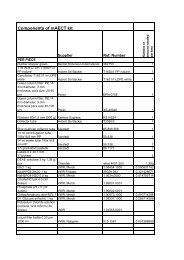
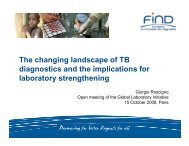
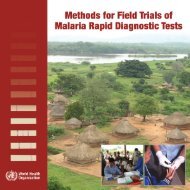

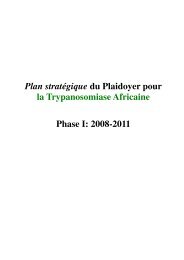
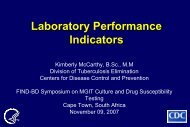
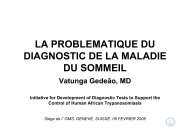
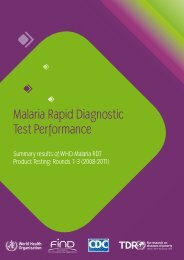
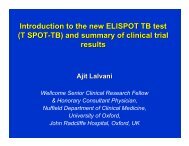
![New laboratory diagnostic tools for tuberculosis control [.pdf]](https://img.yumpu.com/43339906/1/190x135/new-laboratory-diagnostic-tools-for-tuberculosis-control-pdf.jpg?quality=85)
